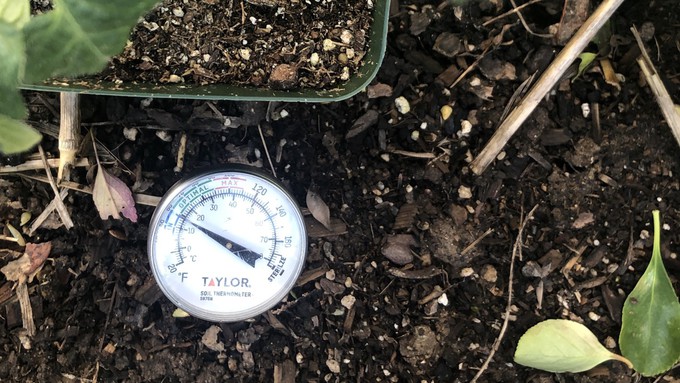
Cold, rainy conditions in forecast for Sacramento

The soil is this garden is 58 degrees -- not quite optimal for planting. That tomato seedling in the container should be transplanted into a 1-gallon pot so it can grow while waiting for the weather to improve. Kathy Morrison
Spring arrived on Monday with a bit of a surprise – sun! Sunday’s storm moved through faster than expected, but another is on its way.
The National Weather Service warns that thunderstorms are possible from noon to 8 p.m. Tuesday for much of the Central Valley and the Sierra with the possibility of gusty wind, heavy rain and hail.
Sacramento is on the fringe of this storm zone; the weather service expects “definite rain showers” to return here Tuesday and Wednesday. Sacramento’s chance of rain Tuesday morning: 90%. “The cool and unsettled weather pattern will continue into next weekend,” the NWS Sacramento office adds.
Sacramento received about a third of an inch (0.35 plus a trace) from this past weekend’s storm. That brought our March total to 3.33 inches. Normal for that 19-day period: 1.8 inches.
These passing storms will be accompanied by gusty winds (25 mph-plus) on Tuesday night. Otherwise, it will be breezy and chilly – definitely sweater weather. Most days will top out below 60 degrees – more than 10 degrees below normal. Tuesday’s forecast high is only 54.
So, even though Monday’s sunny weather felt like “go,” slow down on spring planting. Chilly conditions will put on the brakes to early growth.
Further delaying development of seeds and new transplants: Cold soil. It’s not going to warm up much this week. Overnight lows are lingering in the low 40s. Saturday’s expected low is 37!
You can’t put a sweater on your seedlings, but make sure they stay relatively warm. Use hot caps, row covers, milk jugs or other protection from these still-winter-like conditions. Mulch around plants will add some warmth to their roots, too.
And please, don’t plant tomatoes this first week of spring. They will sit there and sulk, if not curl up and die. If already in the ground, make sure those babies are mulched and protected.
If you have tomato seedlings ready to go (or bought some), transplant them into 1-gallon black plastic pots lined with newsprint. The black plastic absorbs heat and the newspaper insulates the rootball. In late April after soil temperature warms up, move the tomato plant – rootball and all – into the garden. After this head start, the plant should produce tomatoes faster and more of them – especially in warm weather.
What will April bring? According to The Old Farmer’s Almanac, Northern California – and most of the U.S. – can expect warmer than normal temperatures in April and May. After all our rain this season, we should see a lot of spring flowers.
Says the almanac, “Warmer-than-normal spring temperatures for most of the country is good news for gardeners.”
For Sacramento weather updates: https://www.weather.gov/sto/
Comments
0 comments have been posted.Sacramento Digs Gardening to your inbox.
Food in My Back Yard Series
May 6: Maintain soil moisture with mulch for garden success
April 29: What's (already) wrong with my tomato plants?
April 22: Should you stock up on fertilizer? (Yes!)
April 15: Grow culinary herbs in containers
April 8: When to plant summer vegetables
April 1: Don't be fooled by these garden myths
March 25: Fertilizer tips: How to 'feed' your vegetables for healthy growth
March 18: Time to give vegetable seedlings some more space
March 11: Ways to win the fight against weeds
March 4: Potatoes from the garden
Feb. 25: Plant a fruit tree now -- for later
Feb. 18: How to squeeze more food into less space
Feb. 11: When to plant? Consider staggering your transplants
Feb. 4: Starting in seed starting
Sites We Like
Garden Checklist for week of May 4
Enjoy this spring weather – and get gardening!
* Plant, plant, plant! It’s prime planting season in the Sacramento area. Time to set out those tomato transplants along with peppers and eggplants. Pinch off any flowers on new transplants to make them concentrate on establishing roots instead of setting premature fruit.
* Direct-seed melons, cucumbers, summer squash, corn, radishes, pumpkins and annual herbs such as basil.
* Harvest cabbage, lettuce, peas and green onions.
* In the flower garden, direct-seed sunflowers, cosmos, salvia, zinnias, marigolds, celosia and asters. (You also can transplant seedlings for many of the same flowers.)
* Plant dahlia tubers. Other perennials to set out include verbena, coreopsis, coneflower and astilbe.
* Transplant petunias, marigolds and perennial flowers such as astilbe, columbine, coneflowers, coreopsis, dahlias, rudbeckia and verbena.
* Keep an eye out for slugs, snails, earwigs and aphids that want to dine on tender new growth.
* Feed summer bloomers with a balanced fertilizer.
* For continued bloom, cut off spent flowers on roses as well as other flowering plants.
* Add mulch to the garden to maintain moisture. Mulch also cuts down on weeds. But don’t let it mound around the stems or trunks of trees or shrubs. Leave about a 6-inch to 1-foot circle to avoid crown rot or other problems.